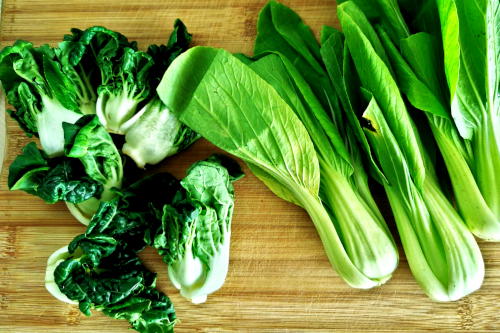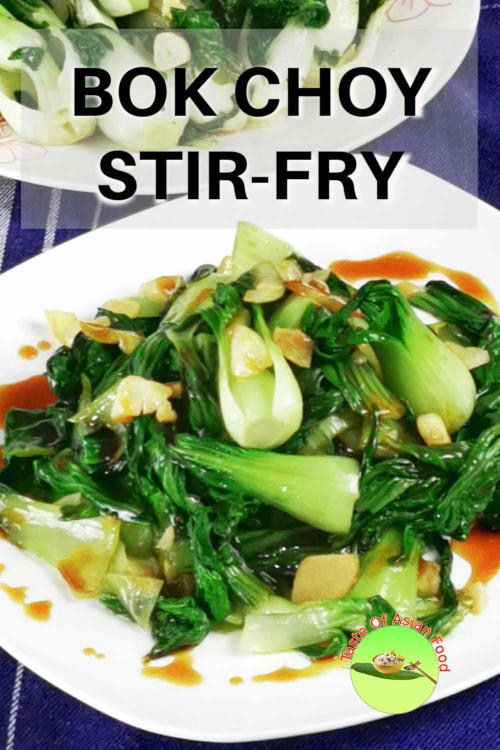How To Use Bok Choy In Stir Fry
This bok choy stir fry might be downright simple for some people, especially those who grew up in a typical Cantonese family. However, it is deceptively tricky to recreate this iconic Chinese dish at home to taste similar those from the restaurant.
This bok choy stir fry recipe will address all the nitty-gritty.
Bok choy is as popular as gailan (Chinese broccoli) and choy sum and is extremely piece of cake to cook. I take cooked this vegetable numerous times by following my mom's methods and experiment with different techniques. Eventually, I settled with the method deemed the best way to cook for my family.
Note: This post may contain chapter links. Delight read my privacy policy for more info. I may receive commissions for purchases made through links in this post. As an Amazon Associate, I earn from qualifying purchases.

What is Bok Choy
Bok choy is also translated equally bak choi, pak choi, bái cài, or bak choy, which are all from the word 白菜. The differences are due to the slight phonetic deviation between the Chinese dialects.
The direct translation of 白菜 is 'white vegetables,' simply they might non necessarily be white. Bok choy leaves are well-baked, with a slightly grassy taste, and mildly bitter. The stalks are either white (yes!), but some can be pale green. The texture is crispy, with a overnice celery-like crunch.
The taste of bok choy is balmy and relatively neutral and is versatile to cook in unlike ways with diverse seasonings.
There are many species, but for culinary purposes, I would group them into the big and the babe bok choy, as the cooking method is slightly different.

How to stir-fry bok choy
The nearly mutual disparity between the abode-cooked version and the eating place version is in that location is not enough wok aroma, and the stem is either as well tough or soft.
Here is the pace-by-footstep breakdown of my methods to recreate this iconic Chinese dish at home.
1. Prepare bok choy for stir-frying
Baby bok choy
Since infant bok choy is just about ii to three inches long, it is better not to cutting them or remove the leaves to preserve their appearance. After all, the stalks are pretty tender, which ways that they will be tender-crisp when cooking them with the leaves simultaneously.
Rinse the babe bok choy with tap water in a large container or pot. Modify the water two to three times to remove all the dirt and sand. Place the bok choy in a colander to bleed the backlog water.
Big bok choy
Since they are larger, cutting off half to 1 cm of the stem from the root portion. Split each stalk and launder separately, either using running h2o or plunge a few times into a pot of water to remove the clay.
Side by side, cutting or snap each stalk crosswise to separate the leaves and the stems. Drain the leaves and stalks separately in different colanders.
Cut the stems on the bias to interruption the fiber. By doing and then, the stem will become just tender-crisp and does non demand to cook excessively long to brand it soft, as the color of bok choy volition turn dull later on prolonged cooking.
Another method is to cut the big bok choy down the centre to create ii halves. This method reveals the stunning pattern of the stem and still keeps the structure intact. However, the structure is fragile, and so it is more appropriate for blanching or pan-frying.
ii. Which is better- to blanch or non to blanch?
Some cooks prefer to blanch the stem of the large bok choy before stit-frying since it takes longer to melt through than the leaves. I used to flinch the larger stems separately with boiling water for a few minutes, so add together to the leaves to stir fry and so that they will go tender-crisp simultaneously. My method has slightly evolved as I thought it is faster to skip blanching.
My current method is to stir-fry the stalk over high heat for two minutes, then add the leaves and go on cooking. They will cook to tender-well-baked at the same time and safety the step to flinch in a dissever pot of h2o.
3 How to season the bok choy
There are four essential ingredients required in this stir fry bok choy recipe.
Garlic is the primary ingredient you must have. It is almost used universally for all types of stir-fried vegetables in Chinese cooking.
Coarsely chop the garlic for stir-frying bok choy. There is no need to finely chop or mince the garlic, which has a counter effect. Since stir-frying involves high heat, finely chopped garlic tends to burn quickly during the process.
The second particular is ginger. It is ever smashing to add two to three thinly sliced ginger along with the garlic. This is the archetype combination virtually used together in all Chinese recipes. It is besides a perfect combination in Indian cuisine, unremarkably, combine as ginger garlic paste.
Some say that ginger tin counterbalance the cooling effect of leafy greens, although that is not why I employ information technology. I just love its taste!
Bok choy is slightly bitter, and then I always add a pocket-sized teaspoon of carbohydrate to rest the bitterness.
Lastly, season with some salt. This bok choy stir fry recipe highlights the taste, texture, and mouthfeel of the vegetable. You lot seldom heard about bok choy used in other heavily seasoned dishes, such as curries.
4. Use a stir-fry sauce (bok choy with oyster sauce recipe)
If yous want to fix a more savory version, I suggest using uncomplicated soy and oyster sauce to switch it upwards to the bok choy with oyster sauce recipe. Behave in mind that the sauce should not overpower but accent the bok choy flavors.
- Combine some low-cal soy sauce, oyster sauce, sesame oil, and h2o in a modest pan.
- Bring it to a eddy to thicken it slightly.
- Drizzle the sauce on the bok choy before serving.
I practice non advise to stir fry the bok choy with this sauce, although I term information technology as a stir-fry sauce. The sauce will have away the vibrant, fresh green color of the bok choy one time you stir-fry together. I prefer to retain the color of the bok choy and use the sauce every bit dressing.

5. Stir fry the bok choy
Here are the steps for baby bok choy stir-fry
- Heat some oil in the wok.
- Add together the coarsely chopped garlic and ginger to saute over depression to medium rut until fragrant and turn slightly chocolate-brown. High heat is not recommended as it will fire the garlic quickly.
- Add the bok choy to the wok. Yous volition hear a loud sizzling sound throughout the entire stir-fry time.
- Plow the heat to high. Continue to stir fry over high heat to generate the wok aroma.
- Season with salt and sugar at any time during the stir-frying process.
- Whenever the liquid in the wok starts to dry out out, add one to two tablespoons of water to the wok to go on stir-frying over high heat. Try to keep minimum h2o in the wok as too much h2o will reduce the wok olfactory property. There should be a constant sizzling sound throughout the stir-frying process.
- Depending on the size of the bok choy, check the doneness (best is to eat one to test), and dish out immediately when the bok choy is tender-well-baked. If information technology is not done notwithstanding, add together another tablespoon of h2o to stir fry further. Keep an eye on the color of the bok choy, as they volition lose the vibrant color if you overcooked it.
Here are the step to stir-fry the big bok choy
Stir fry the stems
- Rut some oil in the wok over depression to medium heat every bit for the minor bok choy.
- Saute office of the coarsely chopped garlic and ginger slices until aromatic.
- Add the tuckered, sliced bok choy stems and stir fry over high heat. Add a tablespoon of h2o at a fourth dimension if it is likewise dry. Keep adding a small amount of water over high heat until the stems are tender-crisp, which takes well-nigh 2 minutes. Of course, the actual timing depends on the size and thickness of the bok choy stems.
- Remove the stems from the wok.
Combine the stems with the leaves
- Add some oil into the pan. Saute the remaining garlic and ginger until effluvious.
- Add the bok choy leaves and stir fry until they start to wither, which will take a minute or two. Add one or 2 tablespoons of water should you find it is too dry.
- Return the nearly cooked stems to the wok. Flavour the bok choy with salt and sugar.
- Proceed stir-frying over high heat until the h2o is nearly dried out. Transfer information technology to the serving plate.
Related dishes to bok choy stir fry recipe
If you lot like this recipe for bok choy stir-fry, you are likely interested in trying the post-obit recipes.
Endeavour to make Bok choy soup with pork by post-obit this recipe. Bok choy is more than than just stir-fry!
Gailan (Chinese broccoli) stir fry. This is my earlier article describing how to stir fry gailan. I flinch the vegetable briefly in this recipe. Y'all tin can refer to information technology if you like to use the blanching method.
Chicken and broccoli stir-fry is a breeze to prepare. It is the ideal dish when you are short of time cooking or have a sudden craving for the Chinese accept-out.
This vegetable stir-fry is quick and easy. Stir-frying adds a whole new dimension to your plain vegetables. Give it a try if you like broccoli, cauliflower, snow peas, and bell peppers.
Prep Time xv minutes
Cook Time 5 minutes
Total Fourth dimension 20 minutes
Instructions
- Rinse the babe bok choy with h2o to remove all the dirt and sand. Bleed.
- Heat some oil in the wok. Saute the coarsely chopped garlic and ginger over low to medium oestrus until fragrant.
- Add the bok choy to stir-fry over loftier heat.
- Season with salt, saccharide, and white pepper.
- Add some water if it is too dry, 1-2 tbsp at a time,
- Stir-fry until the bok choy is tender-crisp.
- Bring all the Ingredients in B to a boil in a small-scale pan to thicken it. Gear up bated.
- Drizzle the sauce on the bok choy. Serve.
Variation for larger bok choy
- Separate the leaves from the stalk.
- Cutting the stem into short sections on a bias.
- Stir fry the stem and the leaves separately.
- When both are tender and nonetheless crisp, combine both in the wok, flavor with salt, saccharide, and pepper.
- Transfer to the serving plate.
Nutrition Information:
Yield:
2 Serving Size:
1
Amount Per Serving: Calories: 95 Total Fatty: 2g Saturated Fatty: 0g Trans Fat: 0g Unsaturated Fat: 1g Cholesterol: 0mg Sodium: 1020mg Carbohydrates: 19g Cobweb: 2g Carbohydrate: 3g Poly peptide: 2g
This data was provided and calculated by Nutritionix on iv/10/2021
How To Use Bok Choy In Stir Fry,
Source: https://www.tasteasianfood.com/bok-choy-stir-fry/
Posted by: mcdonaldoblett.blogspot.com


0 Response to "How To Use Bok Choy In Stir Fry"
Post a Comment